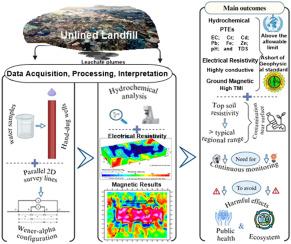了解未捕获的垃圾填埋场污染物、土壤、地下水资源、公共卫生系统及其影响之间的相互作用
IF 7.3
2区 环境科学与生态学
Q1 ENVIRONMENTAL SCIENCES
引用次数: 0
摘要
未捕获的垃圾填埋场渗滤液羽流(ullp)由于其渗入土壤,在各种情况和季节污染地下水资源而成为严重的环境挑战之一。这项研究开创了地面磁测量(GMS)、三维电阻率断层扫描(ERT)和水化学水分析(HWA)数据的应用,以研究ullp与环境之间复杂的相互作用,这些相互作用会对公众健康产生不利影响。结果表明,采样的地下水中pte水平升高,在0.029-1.811mg /l之间,升高到令人担忧的高污染物水平。电阻率数据表明,覆岩表土层的电阻率在1.4 ~ 600 Ωm之间变化,影响带的电阻率较低,在1.4 ~ 10 Ωm之间,发生在0.0 ~ 5.7 m之间。第二层亚表层显示12 - 200 Ωm,增加了部分受影响的区域,而基底岩石显示>;1000Ωm,未受影响,表明潜在的渗滤液流动障碍。磁性数据揭示了填埋场状况的关键信息,总磁性强度(TMI)在未受影响区域的31100 - 37500 nT之间显著变化,在垃圾填埋场内和外的31100 - 41500 nT之间显著变化,在垃圾填埋场内混合材料区域的37500 - 39500 nT之间显著变化。受影响区的TMI值在39000 ~ 41500 nT之间,发生在0.0 ~ 5.0 m深度内。当TMI值超过41500 nT时,填埋区内主要的铁物质会增加,从而进一步加剧了ullp的环境风险。调查结果表明,ULLP污染物影响了地下水的完整性,对公众健康有危险影响。ERT、GMS和HWA的组合提供了一种改进的技术,用于检测和绘制ULLP污染物,获取指导安全废物处理、地下水保护和保护公众健康所需的重要信息。本文章由计算机程序翻译,如有差异,请以英文原文为准。

Understanding the Interactions between Uncaptured Landfill Plume Contaminants, Soil, Groundwater Resources, Public Health Systems, and their Implications
Uncaptured landfill leachate plumes (ULLPs) remain one of the critical environmental challenges due to their infiltration into soil, polluting the groundwater resources with potentially toxic elements (PTEs) in various scenarios and seasons. This study pioneers the application of ground magnetic survey (GMS), 3D electrical resistivity tomography (ERT), and hydrochemical water analysis (HWA) data to examine the intricate interactions between ULLPs and the environment, which inversely affect public health. The results indicate elevated levels of PTEs in the sampled groundwater varying between 0.029–1.811mg/l, heightening alarmingly high contaminants. The resistivity data indicate that the overburden topsoil layers vary in resistivity between 1.4–600 Ωm, with the affected zone having lower resistivity values of 1.4 – 10 Ωm, occurring with 0.0 – 5.7 m. The second subsurface layer exhibits 12 – 200 Ωm, heightening partially affected regions, while the basement rock displays >1000Ωm, remains unaffected, indicating potential barriers to leachate mobility. Magnetic data reveals critical insights into the landfill site’s condition with a total magnetic intensity (TMI) that varies significantly between 31100 – 37500 nT in unaffected zones, 31100 – 41500 nT within and off-landfill site, and 37500 – 39500 nT for mixed-materials zones within the landfill site. The TMI values between 39000 – 41500 nT in the affected zone occur within 0.0 – 5.0 m depths. The TMI values exceeding 41500 nT heighten the ferro-material dominant within the landfill, which further exacerbates the environmental risks associated with ULLPs. Findings indicate that the ULLP contaminants have impacted the integrity of groundwater with hazardous implications for public health. The combined ERT, GMS, and HWA provide an improved technique for detecting and mapping ULLP contaminants, capturing vital information needed for guiding safe waste disposal, groundwater conservation, and protection of public health.
求助全文
通过发布文献求助,成功后即可免费获取论文全文。
去求助
来源期刊

Environmental Pollution
环境科学-环境科学
CiteScore
16.00
自引率
6.70%
发文量
2082
审稿时长
2.9 months
期刊介绍:
Environmental Pollution is an international peer-reviewed journal that publishes high-quality research papers and review articles covering all aspects of environmental pollution and its impacts on ecosystems and human health.
Subject areas include, but are not limited to:
• Sources and occurrences of pollutants that are clearly defined and measured in environmental compartments, food and food-related items, and human bodies;
• Interlinks between contaminant exposure and biological, ecological, and human health effects, including those of climate change;
• Contaminants of emerging concerns (including but not limited to antibiotic resistant microorganisms or genes, microplastics/nanoplastics, electronic wastes, light, and noise) and/or their biological, ecological, or human health effects;
• Laboratory and field studies on the remediation/mitigation of environmental pollution via new techniques and with clear links to biological, ecological, or human health effects;
• Modeling of pollution processes, patterns, or trends that is of clear environmental and/or human health interest;
• New techniques that measure and examine environmental occurrences, transport, behavior, and effects of pollutants within the environment or the laboratory, provided that they can be clearly used to address problems within regional or global environmental compartments.
 求助内容:
求助内容: 应助结果提醒方式:
应助结果提醒方式:


